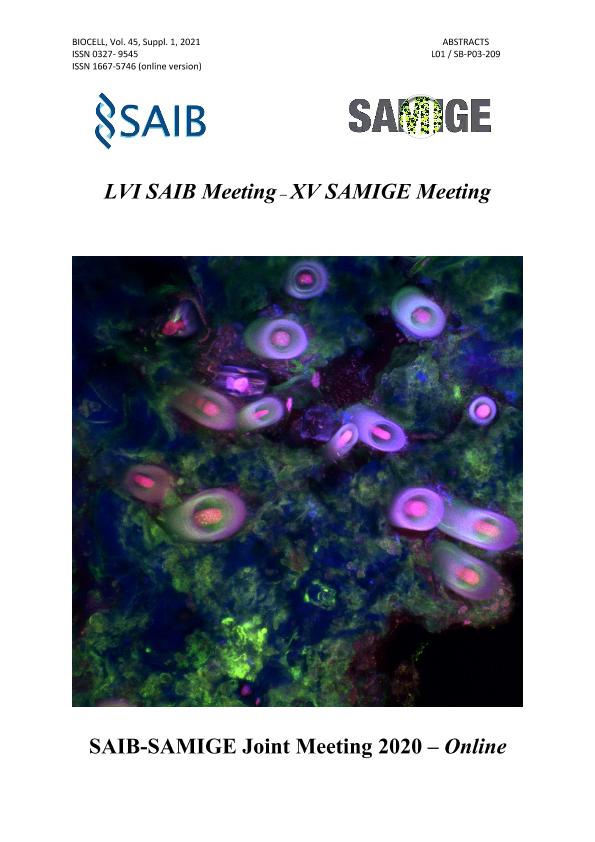Evento
Active calcium mobilization from a thapsigargin-sensitive pool by free 32.5n6 in spermatids
Santiago Valtierra, Florencia Ximena ; Peñalva, Daniel Alejandro
; Peñalva, Daniel Alejandro ; Luquez, Jessica Mariela
; Luquez, Jessica Mariela ; Aveldaño, Marta Isabel
; Aveldaño, Marta Isabel ; Reyes, Juan Guillermo; Oresti, Gerardo Martin
; Reyes, Juan Guillermo; Oresti, Gerardo Martin
 ; Peñalva, Daniel Alejandro
; Peñalva, Daniel Alejandro ; Luquez, Jessica Mariela
; Luquez, Jessica Mariela ; Aveldaño, Marta Isabel
; Aveldaño, Marta Isabel ; Reyes, Juan Guillermo; Oresti, Gerardo Martin
; Reyes, Juan Guillermo; Oresti, Gerardo Martin
Tipo del evento:
Reunión
Nombre del evento:
LVI Annual Meeting Argentine Society for Biochemistry and Molecular Biology (SAIB); XV Annual Meeting Argentinean Society for General Microbiology (SAMIGE)
Fecha del evento:
02/11/2020
Institución Organizadora:
Sociedad Argentina de Investigación en Bioquímica y Biología Molecular;
Sociedad Argentina de Microbiología General;
Título de la revista:
Biocell
Editorial:
Tech Science Press
ISSN:
0327-9545
e-ISSN:
1667-5746
Idioma:
Inglés
Clasificación temática:
Resumen
In their free form, long chain (C18–22) polyunsaturated fatty acids (PUFA), especially 20:4n−6, can modify calcium homeostasis in male germ cells. These cells also contain unusual n-6 very-long-chain (VLC) PUFA (28:4, 30:5, and 32:5), in non-hydroxy (n-V) and 2-hydroxy (h-V) forms, in their membrane sphingolipids. Potential biological roles of VLCPUFA, as free fatty acids (FFA), in the physiology of male germ cells are unknown. In this study we explored the ability of n-V FFA, and their h-V counterparts, to modify the intracellular calcium homeostasis in rat spermatids. After obtaining the n-V and h-V FFA from testicular sphingomyelin, their natural source, each group was separately added to spermatids suspensions at an 8 µM concentration. The n-V FFA increased the intracellular calcium concentration ([Ca2+]i) in spermatids several fold more intensely than did the h-V FFA. After isolating the components of n-V and h-V mixtures by HPLC to study the effect of each VLCPUFA, free n-32:5 was found to be the most active in increasing the [Ca2+]i, followed by n-30:5, while h-32:5 augmented it only slightly. In addition to fatty acid-specific, the response was dose-dependent. The rates of [Ca2+]i upsurge were independent of the presence of extracellular calcium. Pretreatment with thapsigargin inhibited the effect of n-32:5, suggesting that this FFA promotes the release of Ca2+ from intracellular calcium stores, mainly the endoplasmic reticulum. The n-V FFA did not seem to exert their effects through the G protein-coupled receptor GPR120, a putative receptor for free PUFA, as they occurred in the presence of a GPR120 inhibitor. Ceramides containing the same fatty acids did not modify [Ca2+]i, thus the observed [Ca2+]i increases may be attributed to the FFA themselves. The possibility that they occur after VLC-FFAs are converted into other bioactive compounds remains to be investigated. Our results revealed a biological activity of VLCPUFA that suggests a physiological role for these fatty acids. As VLCPUFA-mediated Ca2+ rises occurred in spermatids, they may activate Ca2+ signaling pathways with specific functional targets in germ cells differentiation.
Palabras clave:
FREE VLCPUFA
,
CALCIUM HOMEOSTASIS
,
GERM CELLS
,
SPERMATOGENESIS
Archivos asociados
Licencia
Identificadores
Colecciones
Eventos(INIBIBB)
Eventos de INST.DE INVEST.BIOQUIMICAS BAHIA BLANCA (I)
Eventos de INST.DE INVEST.BIOQUIMICAS BAHIA BLANCA (I)
Citación
Active calcium mobilization from a thapsigargin-sensitive pool by free 32.5n6 in spermatids; LVI Annual Meeting Argentine Society for Biochemistry and Molecular Biology (SAIB); XV Annual Meeting Argentinean Society for General Microbiology (SAMIGE); Mendoza; Argentina; 2020; 1-7
Compartir



